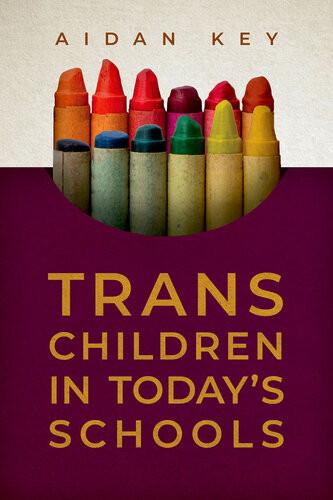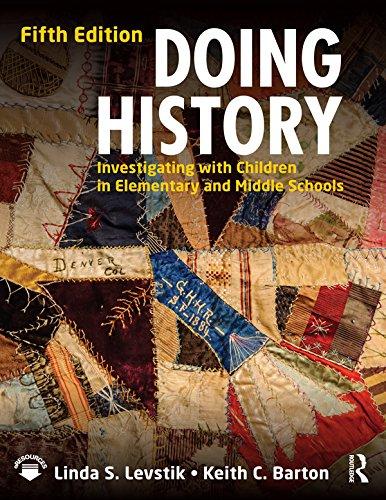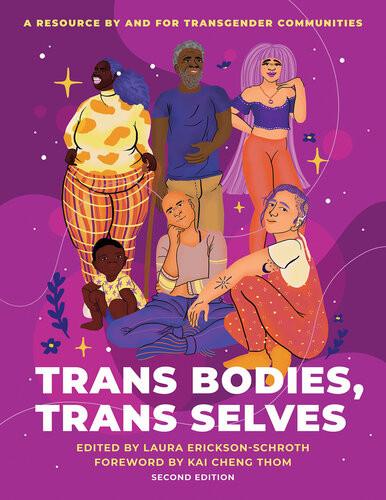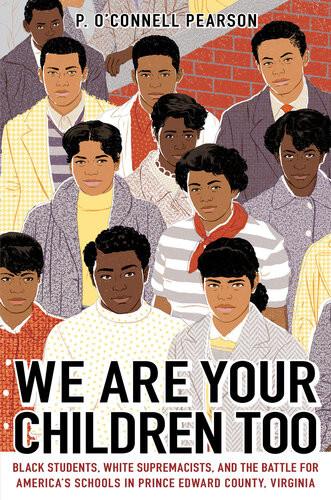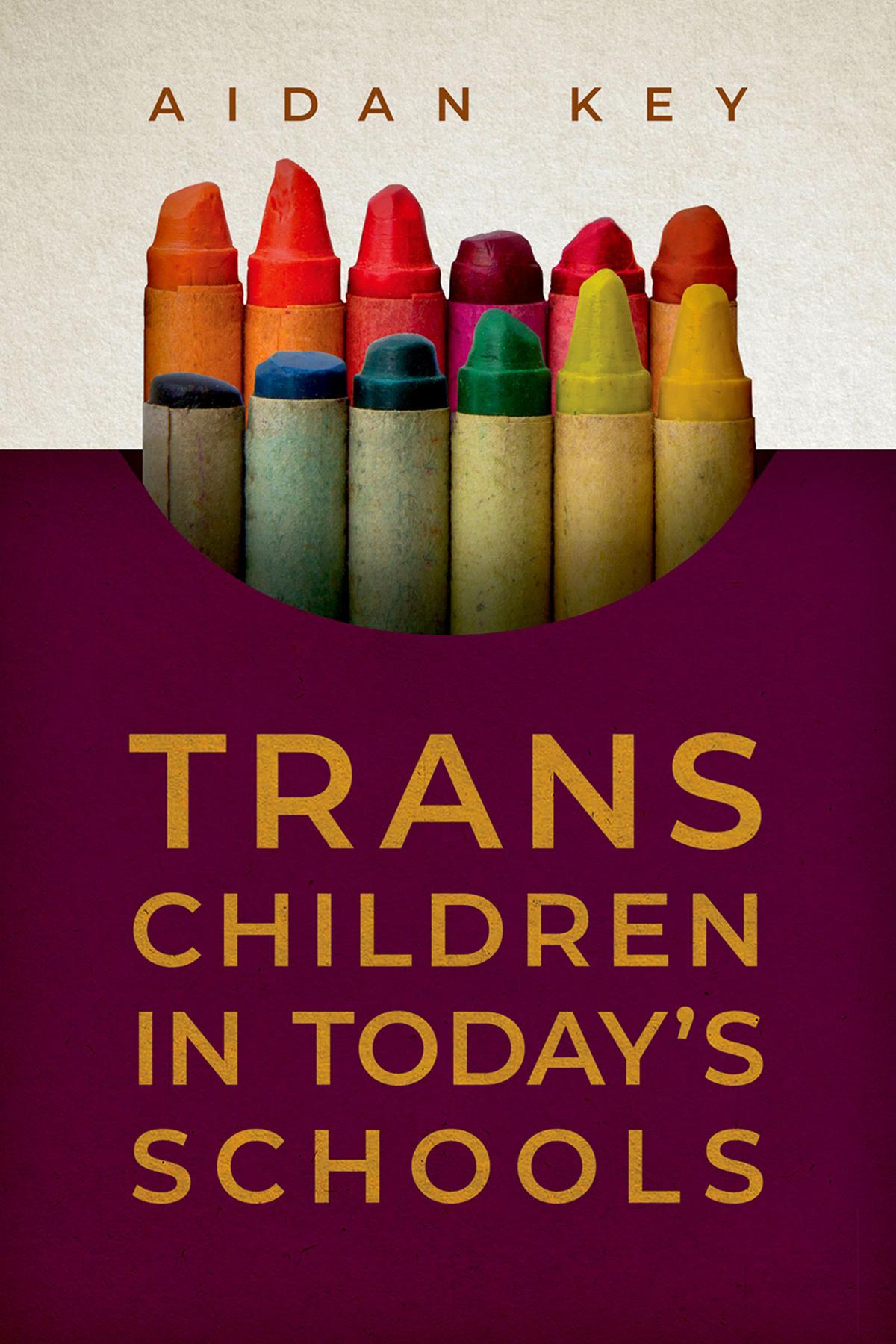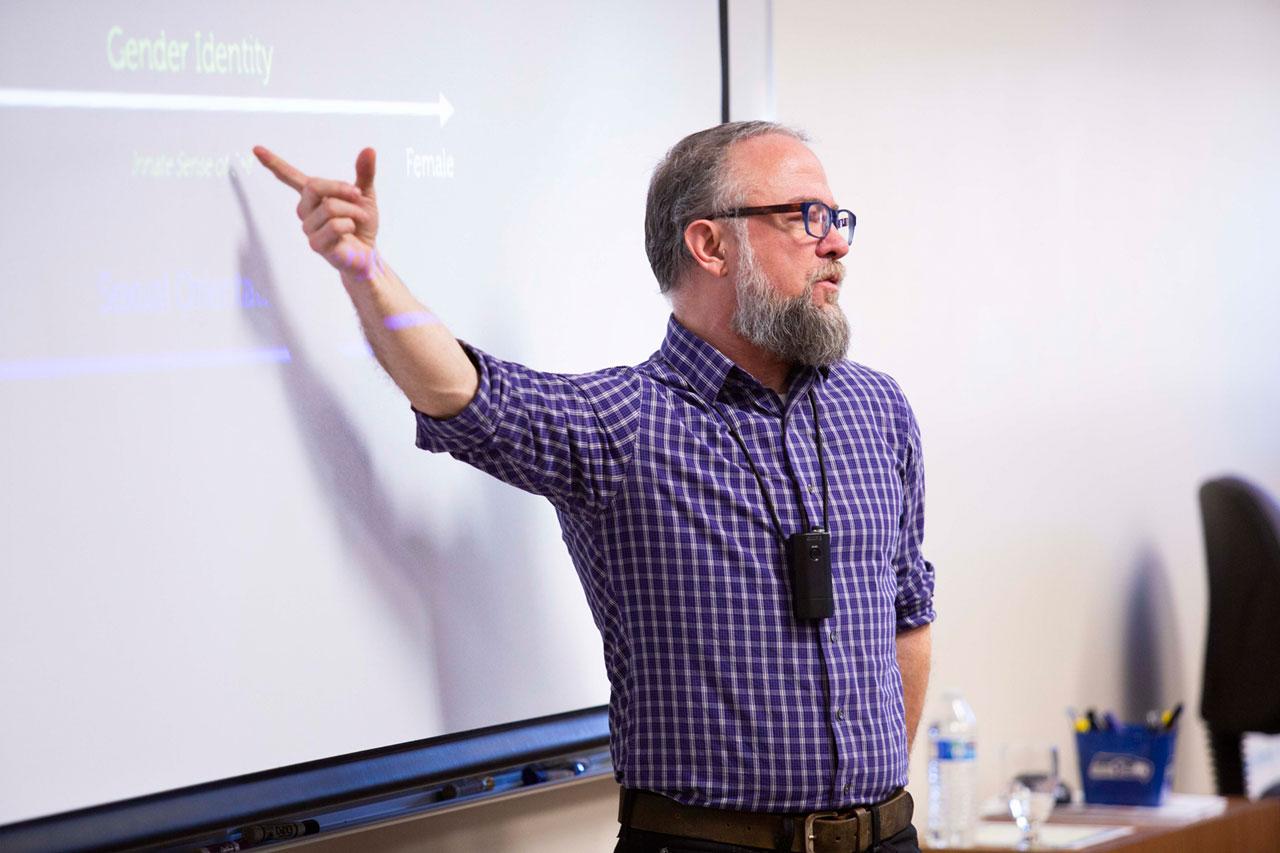FOREWORD BY AARON DEVOR
Many American schools in the twenty-first century have become embattled over the changing meaning of gender. Both parents and educators have become anxious about what young people should be taught concerning the relationship between physical bodies and the everyday enactment of gender. Even as we see unprecedented numbers of youth stepping away from the expectations of their parents’ generations that their genitals should define them, we see our schools continue to be almost entirely organized on binary sex/gender assumptions. Nonetheless, trans, nonbinary, and other gender-diverse (Trans+) children are in schools everywhere, and they deserve to be respected for who they are.
In schools today, who has the right to be a boy, a girl, neither, or both has become a matter of much debate, and no small amount of acrimony. Aidan Key, in Trans Children in Today’s Schools, brings years of experience and a calm common sense to this morass. He understands what it is that Trans+ kids need to thrive. He understands the fears, hopes, and dreams of parents of these children, and of parents of all the other young people who go to school with Trans+ youth. He knows well that all parents want what is best for their children, and that when it comes to Trans+ children, few parents understand what that is, or how to get there from here. He also knows that our educational professionals have dedicated themselves to ensuring that all the children in their care have the best possible experiences in their schools. At the same time, it is clear that Key has important insights into the challenges that educators face in trying to navigate the conflicting demands of legislation, school board policies, parent expectations, and the needs of the full range of the young people who populate schools today.
Having spent years working with parents, kids, families, and school professionals from all across the United States, Key understands. He has seen and heard about the pain and the triumphs. He empathizes with Trans+ kids, and those who care for them, as he walks readers through the complexities of the issues that keep people awake at night. He is a skilled guide who cuts through the hype and hysteria with clarity and compassion. He doesn’t simplify tough questions, nor does he discount the very real concerns of all concerned. He makes it all very real by amply illustrating the knotty challenges using the words of real people as they have talked with him about their anguish and growth in confronting their conflicting thoughts and feelings. What he does is to carefully, and in plain language, provide the information that people need to move beyond unfounded fears and us-versus-them thinking. He helps people to step into approaches that are respectful and safe for children of all genders. He offers practical strategies and techniques to understand and deal with common questions.
Key is, above all, sensible, compassionate, and kind throughout. He never condescends. He never patronizes. Nor does he slide into dogmatism. He looks squarely at the realities of the many stress points between schools that have been built on a strict sex-at-birth–based system and Trans+ children who require something different to thrive. He gently and respectfully acknowledges that change is not easy, and points to different ways that have the potential to be respectful and nurturing to all.
Trans Children in Today’s Schools is a book that should be in the hands of every parent and every educator. Don’t wait until your own child says that they are Trans+. Most never will—but they will have Trans+ friends and schoolmates; they will have Trans+ family members; they will have Trans+ teachers. Don’t wait until you have a gender-diverse student in your school. You need to know this information now. You need to be ready to do the right thing when a vulnerable child looks to you for leadership, guidance, and protection. You will find good, solid, sensible, easy-to-grasp information and advice in this book, and you can come back to it over and over again.
If we all followed Aidan Key’s approach, our schools would be better places for all of our kids, not just the Trans+ kids because, in the final analysis, all kids need the room to explore gender free from the straitjacket of rigid stereotypes. Ultimately, giving Trans+ kids room to grow and thrive creates room for all kids to confidently and safely find, and become, their true selves. Isn’t that what every parent and educator wants for the youth in their care?
Aaron Devor, PhD, FSSSS, FSTLHE, https://onlineacademiccommunity.uvic.ca/ahdevor/
Founder and Inaugural Chair in Transgender Studies, https://www.uvic.ca/research/transchair/
Founder and Subject Matter Expert, The Transgender Archives, https://www.uvic.ca/transgenderarchives/
Founder and Host, Moving Trans History Forward conferences, https://www.uvic.ca/mthf2023/
Professor, Sociology Department University of Victoria, BC, Canada
ACKNOWLEDGMENTS
Over the five plus years it took to complete this book, it has been difficult to describe to others how challenging it was to put these conversations and experiences—and the lives of the humans associated with them—onto the page. I mentioned to one person that extracting the content of this book from my head felt, at times, like stripping the insides of every cell within my body. I sometimes questioned whether the writing was a wise, survivable choice. People assured me that it was, and they were right—the wisdom of it is something that will be revealed in time. We often see the “this book would not be possible without” exaltations of authors, and now I know why!
My wife, Kristin Wilson-Key, bore the lion’s share of ensuring that this book was clear and straightforward. As the person who read the earliest of drafts, she often said, “I know what you are trying to say, Aidan, but you are not quite doing it.” My sister, Brenda Bowers, put on her English tutor hat and supported many of the structural edits. Kristin and Brenda shouldered the emotional support—the most crucial job, from my perspective. Jennie Goode was exceedingly instrumental in getting this book off the ground early on. My only regret is that life demands prevented her from crossing the finish line with me. Speaking of finish lines, Jennifer Nace became the superhero in the eleventh hour. Who in the world geeks out on citations, appendices, line edits, and abstracts? Jennifer does that and so much more. Much gratitude to Scott Peacock—school district superintendent extraordinaire—who advised on every chapter.
I have benefited from the generosity and mentoring of Caitlin Ryan and her remarkable work at the Family Acceptance Project and author Cory Silverberg’s vision of the future. My gratitude goes out
to both Dana Bliss and Stefano Imbert at Oxford University Press. Dana, I know you went to bat for me over and over again. I like to think you won’t regret it. Stefano, thank you for crawling inside my head to extract your beautifully crafted illustrations peppered throughout this book. Thank you to the board, staff, and volunteers at TransFamilies.org who especially encouraged me in the final stretch. Not enough gratitude can ever be expressed to the families of gender-diverse youth who are now part of my family—this book wouldn’t exist without you. Additional thanks must go to Kristina Olson, Aaron Devor, Laurie Frankel, Andrew Solomon, Asaf Orr, Kory Martin-Damon, Bryan Dunncan, Eve Carr, Shari Dworkin, Vlada Knowlton, Arthur Padilla, Eli Green, Sharon Reed, Jimmy Jo Allen, Marlo Mack, Jen Hastings, Kevin Hatfield, Laura Erickson-Schroth, Eleanor Jones, Shannon Panszi, the indomitable Kate Bornstein, and the external reviewers that took precious time to offer input, support, and encouragement. Already offering my mea culpa to those I’ve overlooked on the page but not in my heart.
Introduction
True belonging doesn’t require you to change who you are; it requires you to be whoyou are.
BrenéBrown
BECOMING A GENDER EDUCATOR
In the early 2000s, I began work in the field of gender diversity education, with a focus on the health care and employment industries, as others sought to better serve their gender-diverse constituents. I also founded and directed an international gender
conference that provides educational workshops and a place for much-needed peer discussions. Originally, the Gender Odyssey conference served trans adults and helped strengthen a community where very little had previously existed. It gradually grew to include and address the needs of families with gender-diverse children.
The needs of these families were significant and urgent. Not only did they need guidance on how best to support their children at home but questions about their child’s inclusion at school often found their way to the top of their list. I was deeply moved as I witnessed the way they tentatively but courageously stepped into their fears. The love they had for their child propelled them when they could find little else to grasp. To me, their children were the living, breathing embodiment of a future I had not previously been able to imagine—a future with support, love, and inclusion beginning at the youngest of ages. I turned my full attention—and organization —to them.
By 2007, I had received my first invitation to lead a training for school staff. The impetus for this request was the presence of just one trans child in the third grade. The educators and I knew this was a new conversation—there were no established resources to tap anywhere—and the learning journey for all of us began. None of the educators had ever met a trans person before—child or adult. Their curiosity was high, and their questions were plentiful. It didn’t take long before their questions extended beyond what societal etiquette might usually dictate, including questions about genitalia, sexual practices, and transition-related medical intervention. Their adult curiosities about adult lives were understandable given their lack of exposure, but I pointed out that children were not at all likely to ask the same questions. It was truly an “aha” moment for these teachers.
We then shifted into considering what questions children might actually raise. We identified simple, straightforward questions the kids were likely to ask and readily found our way to straightforward responses. The school staff were pleasantly surprised to see how easy it could be to navigate these conversations with children.
What I learned on that first day, and in the years since, was that we as adults have a more complex path to travel to return to the uncomplicated, powerful place that children intuitively understand. Trans Children in Today’s Schools is my effort to address that complexity—and simplicity—simultaneously.
A few months after my engagement with that first school, I began a support group for parents and caregivers of trans and nonbinary youth. Over the span of more than a dozen years, that group rapidly grew from the handful of families who met monthly at our local children’s hospital to hundreds accessing twelve groups within a onehundred-mile radius. Today, there are thousands of caregivers who meet regularly through our most recent iteration of support— TransFamilies.org. TransFamilies—building on the foundation of the original conference programming and support groups—is a virtual support program that has an expanding, international reach.
When asked how I came to this career path, I will frankly share that it came to me. I chose to respond to the apprehensive educators, the scared but brave families, and so many others when they had nowhere else to turn. Today, after leading hundreds of school staff trainings across the United States and supporting thousands of families around the world, my learning continues and my desire to share that learning is paramount.
AUDIENCE FOR TRANSCHILDRENINTODAY’S SCHOOLS
Each parent who wonders how to best support their unique child often will, in the very next breath, express their fears as to how their child will be received at school. I wrote this book with parents in mind. I want them to have a clear picture of what they may encounter within the educational system. Yet, these parents are not the only audience I want to reach.
The second equally—if not more important—group of people I want to read this book are teachers, administrators, other educators,
and school staff who touch the lives of students on a daily basis. I hope this book finds its way into the hands of university professors and students going into fields of education. I believe there will be many others with personal and/or professional interest in the lives of trans children who will also find this book valuable. What I’ve shared in this book speaks to a particular moment in time when trans and nonbinary children are becoming more and more visible in schools everywhere. It speaks to a time where the roadmap for how and why to strive for greater inclusion is still being crafted.
Whether the reader is a superintendent or coach, parent or grandparent, or college student pursuing a degree in teaching, psychology, law, health care, or social work, my strong hope is that each person will read each chapter regardless of its seeming relevance to them personally or professionally. Here’s why. Chapter 6, for example, gives an overview of what is involved when a child considers a gender transition. It is a lengthy chapter but is important in laying a foundation of understanding that is general and not specific to any single child. Does the head of the cafeteria staff need to know all the potential steps a transitioning child may take? No. But will that staff member ask questions about transition-related steps during a staff training? Unequivocally, yes. Will a school nurse ask about a child’s genital configuration? Unfortunately, yes, they will. Do they need to know? No, otherwise they would ask this of all children. Is it right for them to ask those questions? No. It is important to recognize that a student’s right to privacy supersedes the needs of adults to have their curiosities satisfied. But their questions do mirror those of a society experiencing a significant learning curve. If that cafeteria staffer or school nurse has a resource available from which they can get their questions—or curiosities—addressed, then they can head to school each day with a deeper perspective and an increased understanding of how to honor every child.
If a caregiver is arranging a meeting with a principal to discuss their child’s immediate needs with respect to pronouns, names, and bathroom access, I would like that caregiver to have this resource at their fingertips. Chapters 9 and 10, while primarily addressing
educators, highlight some of the challenges that could, and often do, occur at schools, especially those schools for whom the discussion of gender inclusion is new. A parent will benefit from this perspective as they engage with school personnel.
I strongly hope a principal or superintendent will read Chapter 4 where some of the challenges and heartaches that parents of trans youth face are better understood. Chapter 2 could provide the administrator with much needed insight as to why there is volatility and resistance in these early days of gender inclusion. A more informed administrator can more compassionately recognize the complex path of these families and their children.
If every reader takes in the book as a whole, my hope is that they will come away having gained multiple perspectives regarding the complex relationship between parents and schools as well as an understanding of unprecedented moment in history in which we find ourselves. Change is underway—significant change is imminent—and it is being driven by the crucial needs of these gender-diverse children. I’ve shared many of these children’s stories throughout and I encourage the reader to engage with an open heart and mind.
MORE ABOUT THIS MOMENT IN TIME
We are in the midst of a volatile, messy time when it comes to the “debate” about inclusion of gender-diverse students in schools. Polarizing political debates abound and legal challenges to genderaffirming health care are at an all-time high. Parental support of gender-diverse children is, in some places, viewed as child abuse. Without question, this volatility is painful to watch and is harmful to children. Even as this occurs, I can’t help but contrast it with what I witness day-in and day-out in school districts everywhere. After more than fifteen years of engaging with school districts in conservative andliberal communities throughout the United States, I see consistent progress and burgeoning understanding. This is the lens through which I’ve written this book. It is what provides me
with confident optimism that we can continue this progression and look after these students in the ways they need.
Many readers may be tempted to look ahead to chapters addressing present-day controversies: bathrooms and sports, for example, that come later in the book. If you do skip ahead, I strongly encourage you to circle back to the earlier chapters. I’ve led many trainings where these contested topics are mentioned early on. I always make sure to address these questions, but I’ve found that it is very effective to have a foundation first.
What educators and parents often have in common is a wish for a checklist—something that tells them what to do and when to do it. This wish is understandable yet not entirely realistic. It is important that we figure out what to do in the immediate future and that we commit to this learning. We need to implement some of the long range, systemic changes that will allow us to move out of a time of controversy and volatility. I can share that both educator and parent each desire guidance from the other in the hopes of easing a child’s path and of easing a community’s journey.
The stories in this book are from real families. They have allowed me to use their experiences and photos and they understand the power inherent in doing so. It moves all of us from an abstract, speculative discussion to concrete reality. Anecdotes from educators within schools are included and present real situations and actual conversations. Many weren’t able to be part of this book, but I honor and acknowledge them as being integral to this text.
As is often the case with authors on any subject, I didn’t cover all topics with the depth they deserve. Each chapter could have been its own book. Nor did I cover every perspective for the most obvious reason that I don’t have every perspective. This learning I’ve gained is exclusive to United States public and private schools, as are the stories of the included families. That said, I believe the content of this book can be helpful to people everywhere as it speaks to the humanity in all of us, especially as we navigate times of change.
As the saying goes, write about what you know. Trans Children in Today’s Schools is my effort to share some of the knowledge imparted to me by so many courageous people who have the gift of
being part of a gender-diverse child’s life. All the stories included here were gathered over the course of my twenty-plus years as a gender diversity educator—I have done my utmost to recount accurately the pain, struggles, and joys these families have shared with me as I met them on their journey. I’ve worked with countless families and educators, and I am indebted to each and every one for trusting me with their stories and inviting me into their worlds.
So Many Trans Kids—What’s Going On?
That is what learning is. You suddenly understand something you’ve understoodallyour life, but in a new way.
Doris Lessing
As I stood outside a K–8 parochial school in Oakland, California, I worked on calming my nerves. On that beautiful fall day in 2007, I was still pretty green as a gender diversity educator. I was soon to engage over 150 children in multiple classroom discussions so that they could better understand the upcoming gender transition of one of their schoolmates, a third-grade transgender girl.
The training with staff had gone well, as had the conversation with parents the following day.
Today was about the children. Wrangling large groups of boisterous children may be second nature to teachers, but not to
me. I knew my content, but I could tell that some of it was intimidating to the teachers. None of us wanted the school to make the nightly news, awash with images of scared children and angry parents. Nevertheless, we found the courage to dive in together. We stuck to our respective skill sets—I led the conversation about gender and each classroom teacher took care of the child-wrangling.
As I described the concept of gender identity to the first class, a child raised her hand and said, “That’s me!” Okay, I thought, this must be the trans child (whom I had not met in advance). Afterward, the wide-eyed teacher whispered, “That’s not the child we’ve been talking about!” Okay, so another child is expressing a gender difference. I reassured her that if they could support one child, they would just as easily be able to support two. Off to the next classroom. The same thing happened. As I moved through the day, classroom by classroom, another student or two would raise their hand in the air with statements like: “Everyone sees me as a girl on the outside, but I am a boy on the inside.”
By the end of the day, the principal had heard updates from these teachers. She knew that the conversations had gone well and that, while they knew they had one trans student, the reality might be much greater. “Aidan, could we really have that many trans children? What is going on?!” We discussed this for a bit, and to be reassuring, I added, “Just as you are willing to step into unfamiliar territory to support one known transgender student, so too will these steps serve to support anystudent coming through your doors for years to come.” She smiled, nodded, and replied: “When we say we are committed to social justice and diversity, we do not pick and choose who fits into that category because of what is easiest—or most familiar—gender diversity isour next frontier.”
It is natural for us to speculate about any new phenomenon, even to resist or deny its validity.1 The increased visibility of transgender children in schools and the complexity this presents are no exception. We have learned, to some extent, that transgender individuals have existed and sometimes thrived in other times, cultures, and places, but now we see and hear stories of
transgender people everywhere. Part of this can be attributed to what is known as frequency illusion.2 A parent of a trans boy explained it this way, “It’s like when you buy a red truck. You never notice red trucks and then they are just everywhere!”
Nowhere is this more evident than with transgender children in today’s schools. And not just one or two—there seem to be so many! Administrators and teachers alike may feel broadsided when face-toface with these gender-diverse children. Over and over they ask, “What is going on? Why are there so many? The terms they use— nonbinary, transgender, agender what do these mean and how do we know if this is real when they are so young?”
Frequency illusion is not enough to explain what is really going on. It is important to consider the possibility that we are not witnessing an actual increase in the number of transgender children, but an increase in the visibility and openness of these children and their families. The reality is that trans and other gender-diverse youth are finding their voice. We need to listen. They are insistent upon their need to be seen. We need to pay attention. “In other words, children as a whole have not become more likely to be transgender; rather, transgender children are no longer suffering in silence.”3
WE CAN DO THIS; WE’VE DONE IT BEFORE
Acknowledging and including trans and other gender-diverse children in schools can feel like a daunting task. How do we accomplish this? Do we have models or other examples to follow? If we don’t have the answers to these questions, is that a good enough reason to steer away from making inclusive efforts? No, I don’t think it is.
We can change our society to include those who’ve been excluded, targeted, or hidden—we’ve done it before. In the United States, the latter half of the twentieth century saw progressive social justice movements gathering strength. The civil rights movement sought to racially desegregate schools. The disability rights movement insisted that children with disabilities should not be
hidden away and instead have a right to be included, contributing members of society. Title IX is a law that seeks to increase opportunities for girls by prohibiting sex-based discrimination in educational settings. These movements have not always seen linear progress in how they have changed policy, language, and the very lives they impact. There is always more work to be done. While these movements surely faced obstacles that felt insurmountable at the outset, we now recognize their historical precedent and a present-day need for a sustained commitment to their goals.
Similar to the crucial role of parental advocacy within the disability rights movement, parents today can provide powerful advocacy for the acceptance and inclusion of gender-diverse children. Medical and mental health providers, social and life scientists, and other childhood specialists are serving as vital advocates, by mutually sharing a growing body of research and supplying their observations and experiences.
Teachers and educational leaders also have a pivotal role in this movement toward gender inclusion. They are tasked with creating a supportive environment within schools. Fortunately, the work has begun. If we draw parallels to social justice movements, any adult advocate—parent, teacher, doctor, and others—can better recognize the tools that are available to them and make a positive impact on the lives of all children.
GENDER DIVERSITY IS NOT NEW
Before we examine the present-day visibility of trans children, it will be helpful to take a glance back in time for perspective. Native American cultures during pre-colonial times recognized more than just two gender roles and that these roles were not based on anatomical delineations dependent on genitalia. Often referred to as Two-Spirit, it is estimated that over 150 tribes embraced more expansive gender language, roles, relationships, responsibilities, and presentations.4
Early colonial writings originating from authors such as Spanish conquistador Cabeza de Vaca, fur trader Edwin Thompson Denig of Danish descent, and French artist and member of Jean Ribault’s expedition to the New World, Jacques Le Moyne de Morgues, provide us with observations of these Native American tribes and their acceptance and inclusion of people of differing genders. While individuals who assumed different genders were accepted in most of the Native American societies in which they have been known to exist, the reactions of the Europeans who encountered them ranged from curious astonishment to violent repulsion.5
While three or more gender identity roles existed and were embraced within Native American cultures at one time, the devastation to these people, their culture, and their homeland has all but erased this understanding of a more gender-inclusive world. In their book, Gender: What Everyone Needs to Know, coauthors Erickson-Schroth and Davis write, “Colonization brought an abrupt and violent halt to many freedoms Two-Spirit people had lived with for centuries. Historical accounts present the confusion early colonizers had upon meeting them. Missionaries were often cruel and are reported to have fed Two-Spirit people to the dogs, forced them into the clothing and hairstyles of a cis-normative and eurocentric standard, separated them from family, and altogether erased their histories.”6
Since antiquity, around the globe, there are accounts of genderdiverse people.7 How often do we hear these stories, learn their histories, or see them represented in historical records? As the lives of trans and other gender-diverse people are amplified today, our conceptual understanding of what it means to be transgender serves an important purpose—one where we do not need to vilify, erase, or destroy the lives of other humans to ease the misapprehension of the uninitiated. Instead, we can deepen our understanding of gender-diverse lives and consequently deepen our understanding of what it means to be human.
TODAY’S INCREASED VISIBILITY
Perhaps the most significant factor in today’s visibility of trans children is the world at our fingertips—the internet.8 With the advent of the world wide web, largely inaccessible just twenty-five years ago, we can more immediately access knowledge that may have existed only in larger city libraries or institutions of higher education. If a gender-diverse person wanted to search for information regarding gender identity differences, they would need specialized access, an idea of howto begin their solo search, and the courage to do so. One colleague of mine, attempting to find her way to genderaffirming resources and providers, shared this story with me:
I was in Europe in the early 70s and knew no one who could help. Occasionally, you might hear a whispered story of the gender transition of someone who was the cousin of a neighbor’s friend, but these people were so difficult to track down. Over time, as some of us were finally able to make a few connections, we set up a postal box where others could write to us. Then we created business cards with that address and strategically left them in the card catalog drawers of libraries under content sections where we thought others might look. That is how we found each other!
Over the latter half of the twentieth century, the need for connection led to other resources, such as print newsletters and magazines that served to build a fledgling community. Yet, most would not have access to these resources unless they were in larger cities that might have a gay and lesbian bookstore or community center. The majority of gay and lesbian people did not live open and accepting lives until they reached maturity and could make these integral decisions for themselves. That meant that any resource a person might find was likely to be an adult-focused resource. If a gay or lesbian person’s membership in their community is foundationally defined by their sexual orientation, it reinforces the impression that any community resource that might be available would contain “mature content.” These communities had not yet begun to embrace the distinction between gender identity and sexual orientation, a crucial distinction
that further hindered trans adults who might have had access to these early resources. Adolescents and older teens—whether gay, lesbian, bi, or trans—had to get by on their own, most without familial or emotional support, until they were old enough to access any resources that might exist. During this nascent movement toward gender diversity, younger gender-diverse children were simply invisible and unacknowledged.9
MEDIA AND THE INTERNET
Mainstream media stories about the lives of trans children only started to appear in the mid-2000s. One such story found its way into American homes when, in 2007, veteran journalist Barbara Walters profiled the stories of three transgender children on the television newsmagazine show 20/20.10 Since then, the lives of trans children and their families have become an increasingly regular occurrence in magazines, talk shows, documentaries, and even small-town newspapers.
It should not be hard to imagine then the impact personal computers had as these stories showed up in homes, libraries, and schools. The relative safety, anonymity, and access the internet can afford to an individual or parent is an obvious benefit to those seeking support, information, and validation. Social media giants like YouTube, Facebook, and Instagram provide platforms for the realtime journeys of these families. These stories, which were literally at our fingertips, put real faces to an issue that had, up to that point, been largely ignored, feared, or misunderstood.
Only a decade ago, many of us had never heard the word transgender. Some people may still have the misconception that they have never met a transgender person.11 However, today many people find they have only a degree or two of separation from a transgender person or a family with a transgender child. Your neighbor has a transgender granddaughter. A person at your office recently transitioned. Your child comes home from school and says a
boy she knows is now a girl. With this closer proximity and everincreasing media coverage of this topic, it’s the rare person who has not read an article or heard a radio interview about a transgender child, teen, or adult.
TV programs now increasingly include transgender characters— thankfully, not as a freakish sideshow or as disturbed individuals, but simply as another crucial character in a storyline.12 We see stories in the media representing the diversity of transgender people from all walks of life—musicians, politicians, filmmakers, military elite, clergy, athletes, police officers, and, of course, K–12 students.
As a result of increasing online access, trans children and their parents can more readily find information that addresses their gender identity and experience. The willingness of an increasing number of individuals and families to publicly share their journeys helps others feel less isolated and alone. Their stories provide a name—transgender—to a legitimate and meaningful life experience.
HISTORICAL TREATMENT OF TRANSGENDER INDIVIDUALS
While diverse conceptions of gender may have always existed, there is a minimal historical context for this within a Euro-American mindset. Many trans adults have shared with me that, as children, they had an innate sense that their gender identity did not match their bodies, but with no language with which to describe their identity, it remained nebulous and unspoken.
Of course, some children could (and would) articulate, “I’m not a boy, I’m a girl!” However, those children would likely have experienced immediate pushback. A parent might tell their child that they were confused and seek out gender corrective therapy from a psychologist. The child may face begrudging tolerance at best or active resistance and physical punishment at worst. Many trans children have reported experiences of direct rejection and persecution from others. While a fortunate few had some level of
familial support, they were often subject to harsh experiences outside the home, at school, on the neighborhood playground, with extended family, or within their church communities.13
What we know is that most transgender adults did not receive support or encouragement as children from their family, peers, school, or society for their gender-atypical identities or expressions. These experiences taught them early on to hide their innate, gendered selves as much as possible. These situations were often further compounded when others, unable to intervene because of a lack of understanding, stood by helplessly, either unwilling or unable to offer much-needed support.14
Research shows that today’s adult transgender population, at some point in their lives, including childhood, has experienced physical harm and sexual assault at rates far higher than the national average. These attacks are often delivered with the message that victims deserve “punishment” for not conforming to mainstream norms in the ways they express their gender, for having bodies that aren’t masculine or feminine enough, or for simply stating their core gender identification. Finding a trans-identified adult who has not experienced physical/sexual violence, emotional or sexual abuse, and societal or familial ostracism is a rarity. It is crucial to note that trans women of color are most significantly and disproportionately the victims of violence, sexual assault, and murder.15
Adding to this injustice, those fortunate enough to survive these assaults may find themselves blamed for the attacks, watching as their perpetrators go unpunished, and even find themselves incarcerated for acting in self-defense.
The resulting damage to a trans person’s self-esteem, mental health, and even their ability to function optimally in society does take its toll. This toll, however, is often cited as “proof” that trans people are innately deficient because of their identity rather than suffering from a number of adverse impacts from a hostile society. Pervasive, life-long gender denigration creates a self-fulfilling prophecy that handicaps self-esteem, life-functioning, and personal
